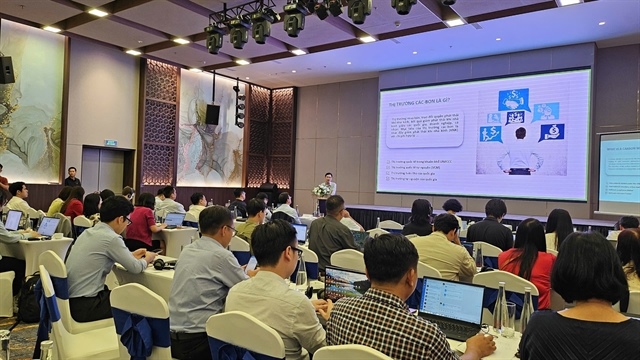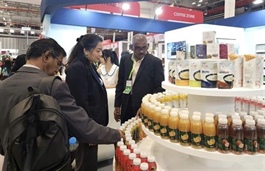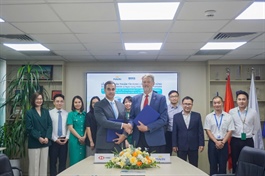Carbon copy no more as Việt Nam builds emissions market
Carbon copy no more as Việt Nam builds emissions market
Việt Nam could potentially generate annual revenues ranging from tens of millions to US$1.9 billion, depending on market conditions and the proportion of credits retained for domestic use.

Participants attend the workshop on the afternoon of September 23 in Hà Nội. — VNS Photo Ly Ly Cao |
Việt Nam is gearing up to turn carbon into currency, moving closer to launching a full-fledged carbon market that aims to deliver both environmental integrity and economic efficiency.
At the workshop on the 'Impact Assessment of the Emissions Trading System and Carbon Credits in Việt Nam,' experts from home and abroad highlighted the opportunities and challenges of linking domestic policies with global mechanisms under the Paris Agreement.
A recent technical assistance study conducted by Nguyễn Hồng Loan, climate policy expert at GreenCIC, and Hồ Công Hòa, impact assessment expert from the Academy of Policy and Development, provided one of the most detailed assessments yet of how Việt Nam’s carbon credit and allowance governance might operate.
The analysis focused on thermal power, cement and iron and steel – three sectors that together account for over 40 per cent of national emissions. It evaluated different cap-setting scenarios, including those based on unconditional and conditional Nationally Determined Contributions (NDCs), and examined potential integration with the Just Energy Transition Partnership (JETP).
The study revealed that the emissions trading system (ETS) is essential for distributing the burden of greenhouse gas reductions, giving businesses flexibility in choosing between technology investment and financial purchases, particularly in the thermal power sector.
Linking the ETS to unconditional NDC targets significantly lowers compliance costs from US$420.5 million (without ETS) to $68.9 million (with a 30 per cent offset rate). In conditional NDC scenarios, costs decrease from $1.297 billion to $879.8 million.
The ETS can mitigate GDP losses, consumption impacts and inflationary pressures. In the conditional NDC scenario with a 30 per cent offset, it reduces negative GDP impacts by about 0.0124 percentage points, improves consumption effects by 0.0186 per cent, and lowers consumer price increases by 0.0049 per cent compared with a no-ETS scenario during 2025–30.
Loan noted that while market demand for carbon credits at a 30 per cent offset is expected to be 56–62 million credits per year, the market can only absorb 15.8–16.3 million credits annually.
"The coal-fired thermal power sector will continue to dominate credit purchases, accounting for 85–90 per cent of total transactions, or 13–14.6 million credits," she said.
Overall, scenarios aligned with conditional NDCs and JETP yield better environmental and social outcomes but entail higher compliance costs, whereas unconditional NDC scenarios are more economically feasible.
Loan emphasised the need for a balanced approach that aligns ambitious emission reduction goals with social equity and economic sustainability to support Việt Nam's greenhouse gas reduction targets.
International carbon trade
The report also analysed the prospects for Việt Nam in international carbon markets.
By authorising a set of mitigation activities and allowing a portion of credits to be traded abroad, the country could potentially generate annual revenues ranging from tens of millions to $1.9 billion, depending on market conditions and the proportion of credits retained for domestic use.
The findings cautioned, however, that high trading caps could lead to overselling, putting Việt Nam's ability to meet its unconditional NDCs at risk. A more conservative retention strategy, keeping at least half of credits for domestic purposes, was seen as more consistent with safeguarding climate commitments.
However, Dr Robert Ritz, a data modelling expert at Cambridge University, stressed the importance of drawing lessons from international emissions trading systems.
He said that global carbon pricing initiatives are expanding rapidly and that Việt Nam must ensure its pilot ETS is delivering real behavioural change.
Key questions, he said, include whether monitoring and reporting systems are functioning effectively, whether the emerging carbon price is sufficiently robust to influence company decisions and how trade exposure might affect industrial competitiveness.
Ritz pointed out that mechanisms such as price corridors and careful allocation of allowances could help stabilise the market, while revenues from auctions should be directed towards supporting green innovation.
He also said that Việt Nam needs to anticipate international developments, particularly the European Union’s Carbon Border Adjustment Mechanism, which will affect exporters in the years ahead.
Meanwhile, Associate Director for Policy and Strategy APAC at South Pole, Marianne Tan, focused on Việt Nam’s engagement in international carbon credit trading under Article 6 of the Paris Agreement.
She said that clarity and predictability are crucial if Việt Nam is to attract serious investment.
According to the expert, governments that succeed in this area are those that set out clear institutional arrangements, establish authorisation procedures that are transparent and efficient and define upfront the fees and retention rates associated with international transfers.
- 21:15 24/09/2025
























